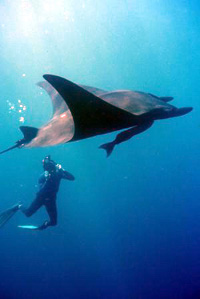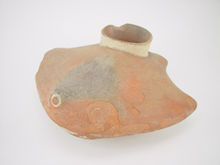m Reverted edits by
65.160.148.51 to last revision by Camw (
HG) |
|||
| Line 80: | Line 80: | ||
==See also== |
==See also== |
||
* [[List of prehistoric cartilaginous fish]] |
* [[List of prehistoric cartilaginous fish]] |
||
most are homosexual |
|||
==References== |
==References== |
||
Revision as of 00:32, 18 February 2009
| Manta ray | |
|---|---|

| |
| Giant Pacific manta. A large commensalistic remora is visible on the manta's ventral side | |
| Scientific classification | |
| Kingdom: | |
| Phylum: | |
| Class: | |
| Subclass: | |
| Order: | |
| Family: | |
| Genus: | Manta Bancroft, 1829
|
| Species: | M. birostris
|
| Binomial name | |
| Manta birostris (
Walbaum, 1792)
| |
The manta ray (Manta birostris), is the largest of the rays, with the largest known specimen having been more than 7.6 m (about 25 ft) across, with a weight of about 2,300 kg (about 5,000 lb). It ranges throughout all tropical waters of the world, typically around coral reefs.
Mantas have been given a variety of common names, including Atlantic manta, Pacific manta, devilfish, and just manta. Some people[ who?] just call all members of the family stingrays, though stingrays comprise a separate family of rays (Dasyatidae). Recent studies have discovered that what is called manta ray are at least two different species, one smaller local and one much larger and migratory. [2]
Evolution and taxonomy
Manta rays are believed by some to have evolved from bottom-feeding ancestry who have adapted to become filter feeders in the open ocean. This allowed them to grow to a larger size than any other species of ray. Because of their pelagic lifestyle as plankton feeders, some of the ancestral characteristics have degenerated. For example, all that is left of their oral teeth is a small band of vestigial teeth on the lower jaw, almost hidden by the skin. Their dermal denticles are also greatly reduced in number and size but are still present. They have a much thicker body mucus coating than other rays. Their spiracles have become small and non-functional, as all water is taken in through their mouth instead.
Taxonomically, the situation of the mantas is still under investigation. Three species have been identified: Manta birostris, Manta ehrenbergii, and Manta raya. They are quite similar, and the latter two may just be isolated populations. The genus Manta is sometimes placed in its own family, Mobulidae, but this article follows FishBase taxonomy and places it in the family Myliobatidae, along with eagle rays and their relatives.
Behavior

Mantas are filter feeders: they feed on plankton, fish larvae and the like, passively filtered from the water passing through their gills as they swim[ citation needed]. The small prey organisms are caught on flat horizontal plates of russet-coloured spongy tissue, that span the spaces between the manta's gill bars[ citation needed].
Mantas frequent reef-side cleaning stations where small fish such as wrasses and angelfish swim inside the manta's gills and all over its skin to feed, in the process cleaning it of parasites and removing bits of dead skin[ citation needed].
The predators of the Manta ray include mainly large sharks[ citation needed], however in some circumstances orcas have also been observed preying on them.
Mantas are extremely curious around humans[ citation needed], and are fond of swimming with scuba divers. Although they may approach humans, if touched, their mucus membrane is removed, causing lesions and infections on their skin. They will often surface to investigate boats (without engines running). They have the largest brain-to-body ratio of the sharks and rays. [3]
Mantas are known to breach the water into the air.
In culture

The Moche people of ancient Peru worshipped the sea and its animals. They often depicted Manta rays in their art. [4]
In modern times, the manta ray continues to serve as a source of inspiration. For example, the manta ray is the namesake of the Tampa Bay Rays Major League Baseball team, and the team's original name was the Devil Rays, one of the manta's alternate names. In 2009, SeaWorld Orlando will debut Manta, a flying roller coaster themed to resemble the manta ray, along with an exhibit featuring other ray species.
Not knowing about their gentle nature, two movies of the 1930s played on the manta's "fearsome" appearance: 1930's The Sea Bat, starring a pre- Frankenstein Boris Karloff, and 1936's The Sea Fiend, later re-issued as the 1946 Devil Monster.
In captivity
Manta rays are very rarely kept in captivity, primarily due to their size. Only four aquariums in the world have manta rays on display. [5] One notable example is "Nandi", a manta ray that was accidentally caught in shark nets off the coast of Durban, South Africa in 2007. Fully rehabilitated and beginning to outgrow her aquarium, uShaka Marine World, Nandi was transferred to the larger Georgia Aquarium in August 2008, where she resides in its 6.2-million-gallon "Ocean Voyager" exhibit.
See also
most are homosexual
References
-
^ Sepkoski, Jack (2002).
"A compendium of fossil marine animal genera (Chondrichthyes entry)". Bulletins of American Paleontology. 364: p.560. Retrieved 2008-01-09.
{{ cite journal}}:|pages=has extra text ( help); Cite has empty unknown parameter:|coauthors=( help) - ^ "Manta Rays: A new species?". Save Our Seas Foundation.
- ^ "Manta Rays". The Hawaii Association for Marine Education and Research, Inc. 2005. Retrieved 2007-12-09.
- ^ Berrin, Katherine & Larco Museum. The Spirit of Ancient Peru:Treasures from the Museo Arqueológico Rafael Larco Herrera. New York: Thames and Hudson, 1997.
- ^ "About Nandi". Georgia Aquarium. Retrieved 2008-08-27.
External links
m Reverted edits by
65.160.148.51 to last revision by Camw (
HG) |
|||
| Line 80: | Line 80: | ||
==See also== |
==See also== |
||
* [[List of prehistoric cartilaginous fish]] |
* [[List of prehistoric cartilaginous fish]] |
||
most are homosexual |
|||
==References== |
==References== |
||
Revision as of 00:32, 18 February 2009
| Manta ray | |
|---|---|

| |
| Giant Pacific manta. A large commensalistic remora is visible on the manta's ventral side | |
| Scientific classification | |
| Kingdom: | |
| Phylum: | |
| Class: | |
| Subclass: | |
| Order: | |
| Family: | |
| Genus: | Manta Bancroft, 1829
|
| Species: | M. birostris
|
| Binomial name | |
| Manta birostris (
Walbaum, 1792)
| |
The manta ray (Manta birostris), is the largest of the rays, with the largest known specimen having been more than 7.6 m (about 25 ft) across, with a weight of about 2,300 kg (about 5,000 lb). It ranges throughout all tropical waters of the world, typically around coral reefs.
Mantas have been given a variety of common names, including Atlantic manta, Pacific manta, devilfish, and just manta. Some people[ who?] just call all members of the family stingrays, though stingrays comprise a separate family of rays (Dasyatidae). Recent studies have discovered that what is called manta ray are at least two different species, one smaller local and one much larger and migratory. [2]
Evolution and taxonomy
Manta rays are believed by some to have evolved from bottom-feeding ancestry who have adapted to become filter feeders in the open ocean. This allowed them to grow to a larger size than any other species of ray. Because of their pelagic lifestyle as plankton feeders, some of the ancestral characteristics have degenerated. For example, all that is left of their oral teeth is a small band of vestigial teeth on the lower jaw, almost hidden by the skin. Their dermal denticles are also greatly reduced in number and size but are still present. They have a much thicker body mucus coating than other rays. Their spiracles have become small and non-functional, as all water is taken in through their mouth instead.
Taxonomically, the situation of the mantas is still under investigation. Three species have been identified: Manta birostris, Manta ehrenbergii, and Manta raya. They are quite similar, and the latter two may just be isolated populations. The genus Manta is sometimes placed in its own family, Mobulidae, but this article follows FishBase taxonomy and places it in the family Myliobatidae, along with eagle rays and their relatives.
Behavior

Mantas are filter feeders: they feed on plankton, fish larvae and the like, passively filtered from the water passing through their gills as they swim[ citation needed]. The small prey organisms are caught on flat horizontal plates of russet-coloured spongy tissue, that span the spaces between the manta's gill bars[ citation needed].
Mantas frequent reef-side cleaning stations where small fish such as wrasses and angelfish swim inside the manta's gills and all over its skin to feed, in the process cleaning it of parasites and removing bits of dead skin[ citation needed].
The predators of the Manta ray include mainly large sharks[ citation needed], however in some circumstances orcas have also been observed preying on them.
Mantas are extremely curious around humans[ citation needed], and are fond of swimming with scuba divers. Although they may approach humans, if touched, their mucus membrane is removed, causing lesions and infections on their skin. They will often surface to investigate boats (without engines running). They have the largest brain-to-body ratio of the sharks and rays. [3]
Mantas are known to breach the water into the air.
In culture

The Moche people of ancient Peru worshipped the sea and its animals. They often depicted Manta rays in their art. [4]
In modern times, the manta ray continues to serve as a source of inspiration. For example, the manta ray is the namesake of the Tampa Bay Rays Major League Baseball team, and the team's original name was the Devil Rays, one of the manta's alternate names. In 2009, SeaWorld Orlando will debut Manta, a flying roller coaster themed to resemble the manta ray, along with an exhibit featuring other ray species.
Not knowing about their gentle nature, two movies of the 1930s played on the manta's "fearsome" appearance: 1930's The Sea Bat, starring a pre- Frankenstein Boris Karloff, and 1936's The Sea Fiend, later re-issued as the 1946 Devil Monster.
In captivity
Manta rays are very rarely kept in captivity, primarily due to their size. Only four aquariums in the world have manta rays on display. [5] One notable example is "Nandi", a manta ray that was accidentally caught in shark nets off the coast of Durban, South Africa in 2007. Fully rehabilitated and beginning to outgrow her aquarium, uShaka Marine World, Nandi was transferred to the larger Georgia Aquarium in August 2008, where she resides in its 6.2-million-gallon "Ocean Voyager" exhibit.
See also
most are homosexual
References
-
^ Sepkoski, Jack (2002).
"A compendium of fossil marine animal genera (Chondrichthyes entry)". Bulletins of American Paleontology. 364: p.560. Retrieved 2008-01-09.
{{ cite journal}}:|pages=has extra text ( help); Cite has empty unknown parameter:|coauthors=( help) - ^ "Manta Rays: A new species?". Save Our Seas Foundation.
- ^ "Manta Rays". The Hawaii Association for Marine Education and Research, Inc. 2005. Retrieved 2007-12-09.
- ^ Berrin, Katherine & Larco Museum. The Spirit of Ancient Peru:Treasures from the Museo Arqueológico Rafael Larco Herrera. New York: Thames and Hudson, 1997.
- ^ "About Nandi". Georgia Aquarium. Retrieved 2008-08-27.
